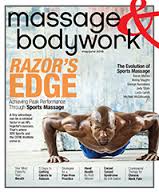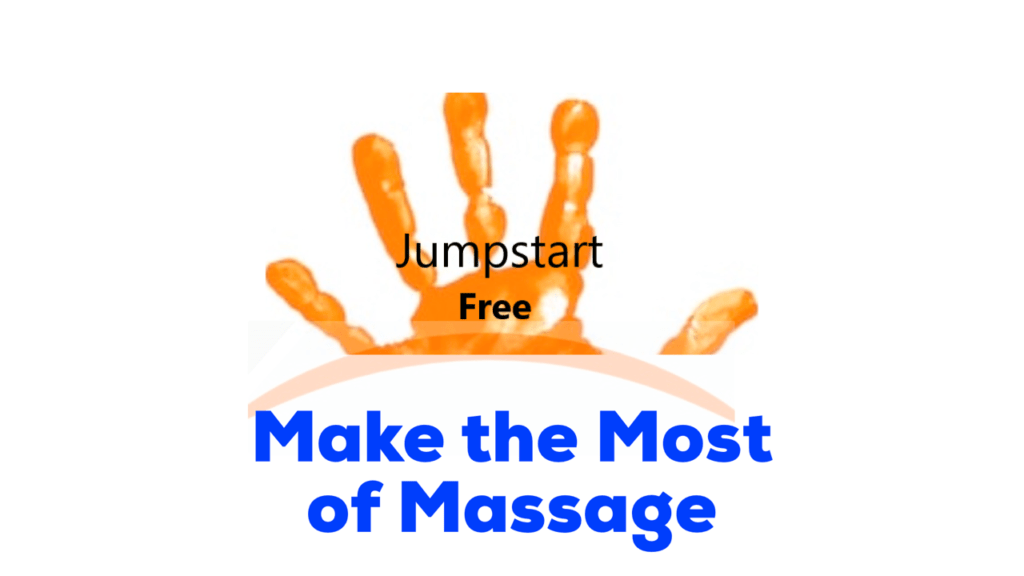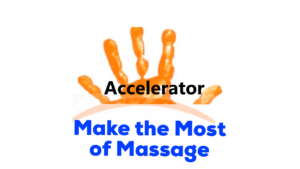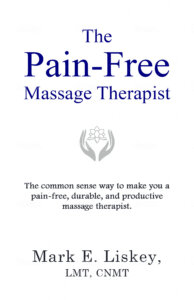The first conversation that I had with a massage therapist didn’t go well. I was 20-something, working out like crazy, and was dinged up with some overuse injuries.
I really wanted to try massage, but massage in the 1980s wasn’t main stream, and finding a legitimate massage person in the Philadelphia, PA suburbs required some work.
At the time I had a gardening business and a client recommended Brenda. I trusted the client. So, why not call?
When I did, let’s just say it was an interesting conversation.
Brenda, speaking in a thick Slavic accent, was annoyed.
Who is this?, she demanded.
Mark Liskey, I said.
Who gave you my number?
Juanita Simpson.
What do you want?
A massage.
Ahhh! I have seven massages tomorrow. Six on Saturday. My God! My hands! You have to have massage?
I thiiink so…
There were sounds of Brenda looking through her schedule book, then she barked: What’s wrong with you?
My knee is bothering me.
What else?
Well, my back hurts some.
That’s it?
I guess.
I heard Brenda’s schedule book slam shut as she said: You can wait. Call back in two months.
Click.
It’s not surprising that this conversation pops up in my mind whenever I experience pain from doing massage.
Massage is physical work. If you do massage for any length of time, you will experience a Brenda moment. My Brenda moment was actually a Brenda year.
Time to Hang Up Your Hands, Dude
It was June of 2013, and I was sweating bullets. I had severe pain in my neck, shoulder and arm, and at the orthopedist’s office, I got some seriously bad news.
An old football injury compounded by years of working out and lots of massage left me with a banged up left shoulder joint, cervical radiculopathy and cubital tunnel syndrome.
“Find a new career,” said Dr. IHaveNoIdeaWhatFindingANewCareerActuallyMeans.
I was no stranger to being in pain from doing massage. Early on in my massage career, I was blowing out my thumbs because of all the detail work I was doing. Why all the detail work? I was certified in and practiced neuromuscular massage therapy (NMT).
One NMT concept was that you must work the origin, insertion and body of the muscle for the best release. As thorough of a massage this was for the client, it was equally thorough in beating up the MT’s hands.
I guess I should have seen this coming. When I was going through the NMT program I would do exchanges with my friend, Maggie, who was also going through the program with me. One day she walked in with all her distal finger joints taped. She looked like she could have been in the Spirit of 76 Revolutionary War painting next to the fife player with the head-bandage and carnage all around him.
I’m not knocking NMT. It was a comprehensive program that launched my massage career, but it was also client-centric, meaning it was focused on the client’s well-being with little attention given to the therapist’s durability.
NMT was not alone in this category. Pfrimmer had a reputation of sending MTs to a very early retirement because the techniques severely stressed the practitioner’s hands. And sacrificing your hands to get the job done didn’t seem to be exclusively an American idea either.
Once an acupuncturist from China who I shared office space with told me that I should learn the Chinese massage he did because it was so much superior to the massage I did.
I said, Okay, can you show me some techniques?
He said, No.
Initially, I was ticked because I thought he was withholding information that could help me be a better therapist. But as the conversation went on he eventually confessed that the massage he did—that was so superior to my massage—hurt his hands way too much for him to show me.
Right, the operative word was “did” and the message to me continued to be that in order to be a rock-star MT you needed to kill your hands.
When I look around at new MTs coming into the business today, I don’t think the idea of sacrificing your body to do your job has gone away. It’s an idea that when you look at it more closely, doesn’t make a lot of sense.
Granted, you sometimes have to do things that make your body temporarily uncomfortable to get the job done. But if you’re consistently and blindly throwing a body part into harm’s way, you’re not going to last. And you’re going to start resenting your work and your clients.
The T-bar Paradox
Fortunately for me, I had an entry point for experimenting with ways to massage in less pain. NMT was big on massage tools, like the T-bar.
The T-bar is a simple tool, shaped like a T with a plastic or rubber tip.
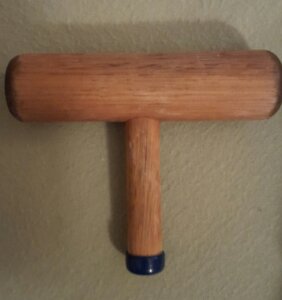
The function of the T-bar in NMT was to help the MT reach and apply pressure to muscle attachments and a byproduct of using a T-bar was that it could be a thumb replacement.
In other words, get the spot with the T-bar and if it helped your thumbs, great. If not, oh well.
Eventually, the “sacrificing your body to get the job done” mindset started to crack because the longer I did NMT and the more clients I saw, the more the T-bar hurt my fingers.
There’s an easy explanation for why the T-bar hurt my fingers. In NMT we were taught to grip the tip of the T-bar to control it, sort of like how you hold a pen or pencil.
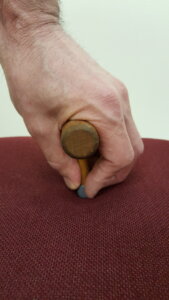
That gripping put serious stress in the 1st, 2nd and 3rd distal finger joints. A little gripping, a light client-load for the day, was okay. But if I had a normal or heavy client-load for the day, my fingers hated me.
My next thought was that I could design a massage tool that would be easier on my hands.
There was inherent problem with this idea which is I’m pretty good at destroying things, but not so good at building things. Just ask my wife, Lisa.
Fortunately, my dad, a Depression era kid, who could build a house with toothpicks, old newspapers and discarded dental floss was up for the job and together we created a lot of massage tools, like the monster tool.
The monster tool is aptly named. The tip of the monster tool was over 2 inches long and looked liked like a drill bit.
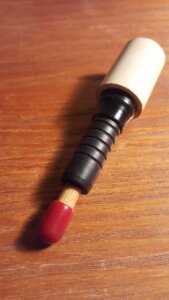
The handle was about 14 inches long, and the butt of the handle would rest in the front of my armpit.
The monster tool soon became my favorite tool, but no client every saw it. Could you imagine being on the massage table and seeing what looked like a drill bit coming at you forearm?
Over the next ten years I brought all my Dad-made, massage tools into the massage room with me, but to my dismay none of the tools, including my beloved monster tool, saved my hands.
And as my business grew, my body started racking up more damage, like the cervical radiculopathy, cubital tunnel syndrome, and unstable left shoulder that I mentioned in the opening.
The Massage Pain-Free Experiment
In one last attempt to save my massage career, I gave myself an ultimatum: You have a year to fix your body or you quit massage.
The good news was that I wasn’t starting from scratch. I knew that there was no perfect tool that was going to solve my hand pain issue, and I also learned that using a variety of massage tools reduced some hand pain because I wasn’t stressing the same muscles in my hands all the time.
The question was why didn’t using a variety of massage tools stop my hand pain altogether?
The answer had literally been staring me in the face for years and the monster tool held the key.
Though the monster tool looked like it should be part of a dawn-of-dentistry tool kit, it had one advantage over all the other tools. It was designed so that the handle fit into the front of an armpit. To exert pressure you pinned the monster tool between the front of your armpit and the tissue you were working on and then leaned. You could then relax your holding-hand because you only needed to steady the massage tool since your body weight was doing all the work.
So, what if I took the monster tool “lean and pin” concept and applied it to all massage tool usage? It was my “it’s not the dog, it’s the dog owner” revelation. The tool wasn’t the problem, it was how I was holding the tool.
Instead of using the NMT “grip the tip” approach to holding the T-bar, I tried the monster tool “lean and pin” idea to hold the T-bar and sure enough, I was able to relax my grip. In fact, I could even open my hand.
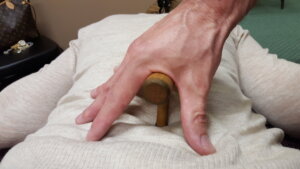
As I experimented with the lean and pin technique I soon discovered that I could steady the massage tool in many different ways. I was like a kid in a candy store as I explored the different holds.
I have to admit that at the same time of experiencing this breakthrough joy, I also sort of wanted to cry. The joy part was that I essentially figured out how to save my hands. The crying part was, Seriously, dude, it took you this long to figure that out?
But I wasn’t out of the woods yet—my shoulder, elbow and neck still hurt.
Fixing my other body parts required some introspection, which wasn’t as straightforward as leaning and pinning a massage tool.
Maria Konnikova, author of the The Biggest Bluff, says that life can be boiled down to making decisions with incomplete information. If you want to make the best decision you not only need the best information that can be known, you also need to know the person making the decision—you.
Here’s a piece of self-information that took me a while to get: I’m a smiley-face collector. I want to please people. If I make someone happy, I get a shot of dopamine—boom!—and life is good.
It’s not surprising that I chose a career where I can get shots of dopamine all day long. When a client gets off my table, she’s happy (most of the time, haha), and that means Markie is not only going to get paid, he’s also going to get a shot of dopamine. Sweet. And this goes on all day long.
What other job gives you that many opportunities for collecting smiley faces? Not many. And by the end of a massage work day, my internal pharmacist is saying, Let me guess, another order of dopamine.
I’m thinking that being a people pleaser is one of the reasons you do massage and that your internal pharmacy is also cranking out the dopamine.
But here’s a potential problem: If you’re like me, all that people-pleasing dopamine can override the pain tolerance or self-preservation mechanism. In other words, we get the dopamine reward for jamming our thumb into Maria’s lamina groove to help her back pain go away, but we also get a thumb that hurts more and more with each deep tissue massage we do, which is a set up for a major showdown between their pain versus my pain.
Their Pain Versus My Pain
I remember a “their pain versus my pain” showdown that had a major impact on how I do massage to this day. Jamar was my last massage of a long day. I was a month or so into my year long experiment to eliminate pain when doing massage, and though I had been experimenting with different ways to hold massage tools, my fingers were still a little cranky.
I was about to do supine work on Jamar’s tight neck, and I could feel myself tensing as I anticipated the pain that was about to occur in my hands when a voice in my head said: Why are you doing supine neck work when you know it hurts your fingers?
The question stunned and exhilarated me at the same time. The stunning part was the question revealed that I wasn’t really looking out for my body because I was continuing to do techniques that hurt my body. The exhilarating part was that I recognized this was a choice.
So, I picked up a T-bar with a thin stem.
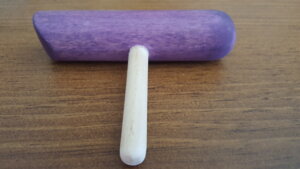
And with guide finger down next to the tip I started to do prone neck work. When I felt that I was losing sensitivity I switched to a thumb, and when that thumb started to feel a little discomfort I switched to two thumbs bracing each other. I went back and forth between massage tool, thumb and barred thumbs without every working on Jamar’s neck in the supine position. And at the end of the massage, my fingers felt good.
The horse was out of the barn—forever. Never again was I going to do a technique that hurt my body.
If you’re thinking “yay, massage pain-free”, but “boo, massage tools”, don’t worry, you don’t have to use massage tools to massage pain-free.
Using massage tools is only one strategy to massage pain-free. There are more.
Here are all the strategies that I use to stay out of pain when doing massage:
(1) think pain-free first,
(2) lock, stack and lean to generate pressure,
(3) use the massage table to support your body weight and to regulate pressure,
(4) break static postures,
(5) combine body parts,
(6) become ambidextrous,
(7) use a variety of techniques and strategies.
Some of these strategies seem fairly straightforward, like become ambidextrous. And some like, think pain-free first, seem a little more esoteric. But I promise you that by the end of this book all these strategies will make sense without you having to burn extra brain glucose.
By the way, you don’t have to master all the strategies to massage pain-free.
Take in these strategies like how Bruce Lee, the famous martial artists, approached new information, “Absorb what is useful, discard what is useless and add what is specifically your own”.
That said, this book is about strategies, not axioms. Work a strategy. If it’s a fit for your body, problem solved. If not, modify it or move on to the next one. My goal is not to be your trail blazer. My goal is to give you the tools so that you can blaze your own trail to massaging pain-free.
Well, we can’t talk our way to pain-free. So, put your helmet on and buckle your seat belt because the first thing we’re going to do is to break some unconscious rules and challenge the entrenched and non-useful ways of thinking that are preventing you from massaging pain-free.
Book Release Sign-Up
If you want to know when Massage Pain Free is right off the press, sign up below and I’ll give you the heads-up.


